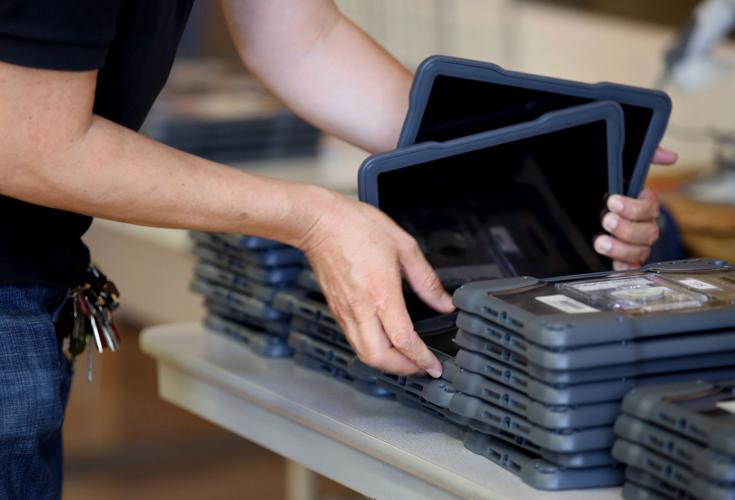Students at TUSD’s Lawrence 3-8 School, near the Pascua Pueblo Yaqui Reservation, explored their new tablets on Thursday, part of a nationwide effort to close the digital divide that disadvantages under-served communities.
A small group of middle schoolers — the student tech team — help their peers unlock the new devices and look through the educational apps. A video projected tips on how to be a responsible digital citizen. Verizon innovative coach Dallas Lara answered parents’ questions. And Principal Zulema Stanbrook chatted with students who had been eagerly waiting for this day.
Every student in sixth through eighth grade at the small school received a tablet computer on Thursday as part of the new Verizon Innovative Learning Schools initiative. At Lawrence, near West Valencia Road and South Camino de Oeste, 92% of students receive free and reduced school lunch, and many families do not have internet access at home, Stanbrook says.
Middle schoolers at three Tucson Unified School District schools, including Mansfeld Middle Magnet and Pueblo Gardens PK-8, each received a tablet along with a two-year data plan, which travels with the device whether the kids are at school or at home.
One goal of the initiative is to change the digital divide in America, says James Butler, director of instructional technology at TUSD, who’s leading the program for the district.
“We are literally closing the digital divide a little bit,” he said. “This is a game changer.”
Since 2012, Verizon Innovative Learning has committed about $400 million to the program, according to a TUSD news release. The three TUSD schools are among 52 schools across the nation joining the program this year for a total 152 schools.
Schools nationwide who apply for the competitive grant need to have at least 67% of the students receiving free and reduced lunch, be achieving academically and service grades 6 through 8, Butler says.
Along with the tablets and data plans, the initiative grant covers extensive and ongoing professional development, all amounting to $1.8 million spent on each school, Butler says. The professional development paid for by the grant began with key people in the district traveling to schools in Kentucky to observe the program in action.
The teachers in participating grades began their first session of professional development before the school year even started, learning different ways to apply the approved TUSD curriculum in a digital space. They’ll receive two more rounds of professional development later in the year.
“How can we infuse Verizon Innovative Learning Schools into what you want your schools — your learning community — to look like?” Butler says. “How do you want to use this device in order to deliver instruction and to make a real difference in the lives of kids?”
Teachers at Lawrence have been exploring educational e-books, websites for math skills, a tuner app for music class, a camera and video app for art class, incentives to keep kids engaged over the fall break, and more, says Stanbrook.
What students can access on their tablet at home is up to the district, but typically they don’t have access to social media or anything else that’s not educationally enriching, said Sara Crawford, Associate Director of Professional Learning with Digital Promise, the nonprofit partner with the initiative, which delivers the professional development and answers technical questions.
Crawford will be meeting with educators at Lawrence weekly for the next two years to offer support. The program pays for each school to have an instructional coach, like Crawford, for ongoing professional development. And for an additional two years after that, each school can apply for virtual support.
There’s also an online community designed to connect schools in the program to share advice, problem solve and innovate. There are also additional grants TUSD can apply for that are only open to schools in the program, Butler says. And TUSD technology staff at each school trained a student tech team to show their peers how to use the tablets and help solve any problems.
“Not only does that increase engagement,” Butler says, “but it gets kids even more comfortable and more immersed with technology for the 21st century.”
Samuel Godoy is one of seven students on the tech team at Lawrence. The seventh-grader, who doesn’t have internet at home, said he’s good with technology because he helps his mom when she has problems with her phone, and he’s excited about this new opportunity.
His mother Josephine Godoy is excited for her son to gain technology-related skills and take on more responsibility. She says this is a new experience for many low-income parents.
Lawrence is one of the main schools for Yaqui students, and for some of them this will be their first time having internet at home, said Daniel Gastelum, the supervisor of Yaqui Educational Services.
For students struggling to keep up, the program is “allowing them to have that seat at the next generation table,” he said. “To get resources like that also lifts morale.”
Crawford, with Digital Promise, said although the program is still in its beginning stages, they have already seen academic achievement increase in schools in the program, through growth in ELA scores and increased interest in STEM careers.
She says the goal is to “bridge the digital equity gap and level the playing field.”





